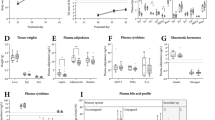Abstract
Two experiments were conducted. In Experiment 1, 8-wk-old mice were fed control diet or diet supplemented with 0.5% conjugated linoleic acid (CLA) to study the effect of CLA on body composition (CLA: 40.8–41.1% c-9,t-11 isomer, 43.5–44.9% t-10,c-12 isomer). The data for CLA-fed mice vs. controls described parallel but significantly distinct responses for both absolute and relative changes in body fat mass (reduced in CLA-fed mice) and for relative changes in whole body protein and whole body water (both of which were increased in CLA-fed mice). In the CLA-fed mice, the effect on whole body protein appeared to precede the reduction in body fat mass. In Experiment 2, weanling mice were fed control diet or diet supplemented with 0.5% CLA for 4 wk (test group), at which time all mice were fed control diet devoid of added CLA. The test group exhibited significantly reduced body fat and significantly enhanced whole body water relative to controls at the time of diet change. Time trends for changes in relative body composition were described by parallel lines where the test group exhibited significantly less body fat but significantly more whole body protein, whole body water, and whole body ash than controls. Tissue CLA levels declined following the withdrawal of CLA from the diet. In skeletal muscle of mice fed CLA-supplemented diet, the t-10,c-12 isomer was cleared significantly faster than the c-9,t-11 CLA isomer.
Similar content being viewed by others
Abbreviations
- ANOVA:
-
analysis of variance
- CLA:
-
conjugated linoleic acid
References
Ha, Y.L., Grimm, N.K., and Pariza, M.W. (1987) Anticarcinogens from Fried Ground Beef: Heat-Altered Derivatives of Linoleic Acid. Carcinogenesis 8, 1881–1887.
Doyle, E. (1998) Scientific Forum Explores CLA Knowledge, INFORM 9, 69–72.
Park, Y., Albright, K.J., Storkson, J.M., Cook, M.E., and Pariza, M.W. (1997) Effect of Conjugated Linoleic Acid on Body Composition in Mice, Lipids 32, 853–858.
DeLany, F.P., Blohm, F.Y., Truett, A.A., and West, D.B. (1998) Dose Response of Conjugated Linoleic Acid (CLA) on Mouse Body Fat, FASEB J. 12, A504.
Houseknecht, K.L., Vanden Heuvel, J.P., Moya-Camarena, S.Y., Portocarrero, C.P., Peck, L.W., Nickel, K.P., and Belury, M.A. (1998) Dietary Conjugated Linoleic Acid Normalizes Impaired Glucose Tolerance in the Zucker Diabetic Fatty fa/fa rat, Biochem. Biophys. Res. Comm. 244, 678–682.
Sisk, M., Azain, M.J., Hausman, D.B., and Jewell, D.E. (1998) Effect of Conjugated Linoleic Acid on Fat Pad Weights and Cellularity in Sprague-Dawley and Zucker Rats, FASEB J. 12, A536.
Dugan, M.E.R., Aalhus, J.L., Schaefer, A.L., and Kramer, J.K.G. (1997) The Effects of Conjugated Linoleic Acid on Fat to Lean Repartitioning and Feed Conversion in Pigs, Can. J. Anim. Sci. 77, 723–725.
Cook, M.E., Jerome, D.L., Crenshaw, T.D., Buege, D.R., Pariza, M.W., Albright, K.J., Schmidt, S.P., Scimeca, J.A., Lofgren, P.A., and Hentges, E.J. (1998) Feeding Conjugated Linoleic Acid Improves Feed Efficiency and Reduces Whole Body Fat in Pigs, FASEB J. 12, A836.
Thiel, R.L., Sparks, J.C., Wiegand, B.R., Parrish, F.C., Jr., and Ewan, R.C. (1998) Conjugated Linoleic Acid Improves Performance and Body Composition in Swine, Midwest Animal Science Meetings 1998 Abstracts, p. 61, Midwestern Section, American Society of Animal Science, Savoy, IL.
Dunshea, F.R., Ostrowska, E., Muralitharan, M., Cross, R., Bauman, D.E., Pariza, M.W., and Skaric, C. (1998) Dietary Conjugated Linoleic Acid Decreases Back Fat in Finisher Gilts, J. Animal Sci. 76 (Suppl. 1), 131.
Cohen, L.A., Choi, K., and Wang, C.-X. (1988) Influence of Dietary Fat, Caloric Restriction, and Voluntary Exercise on N-Nitrosomethylurea-Induced Mammary Tumorigenesis in Rats, Cancer Res. 48, 4276–4283.
Ha, Y.L., Storkson, J., and Pariza, M.W. (1990) Inhibition of Benzo(α)pyrene-Induced Mouse Forestomach Neoplasia by Conjugated Dienoic Derivatives of Linoleic Acid, Cancer Res. 50, 1097–1101.
Chin, S.F., Liu, W., Storkson, J.M., Ha, Y.L., and Pariza, M.W. (1992) Dietary Sources of Conjugated Dienoic Isomers of Linoleic Acid, a Newly Recognized Class of Anticarcinogens, J. Food Comp. Anal. 5, 185–197.
Sehat, N., Yurawecz, M.P., Roach, J.A.G., Mossoba, M.M., Kramer, J.K.G., and Ku, Y. (1998) Silver-Ion High-Performance Liquid Chromatographic Separation and Identification of Conjugated Linoleic Acid Isomers, Lipids 33, 217–221.
Helrich, K. (1990) Official Methods of Analysis, 15th edn., pp. 935–937. Association of Official Analytical Chemists Inc., Arlington.
Forbes, G.B. (1996) Body Composition, in Present Knowledge in Nutrition (Ziegler, E.E., and Filer, L.J., Jr., eds.), pp. 7–18, ILSI Press, Washington, DC.
Satory, D., and Smith, S.B. (1998) Conjugated Linoleic Acid Inhibits Proliferation, but Stimulates Differentiation of 3T3-L1 Preadipocytes, FASEB J. 12, A552.
Author information
Authors and Affiliations
Corresponding author
About this article
Cite this article
Park, Y., Albright, K.J., Storkson, J.M. et al. Changes in body composition in mice during feeding and withdrawal of conjugated linoleic acid. Lipids 34, 243–248 (1999). https://doi.org/10.1007/s11745-999-0359-7
Received:
Revised:
Accepted:
Issue Date:
DOI: https://doi.org/10.1007/s11745-999-0359-7




